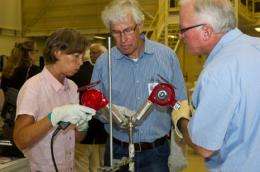From left to right: Petra Neuhause and Harold Lenski, both with Astrium, Germany accompanied by Jeff Clancy of Teledyne Brown Engineering, use a heat gun to open the first U.S. sample cartridge processed in the solidification quench furnace in the Materials Science Research Rack aboard the International Space Station. The sample was returned to Earth on the space shuttle mission STS 133. Credit: NASA/MSFC/Emmett Given
If you think it's tough to make Baked Alaska or a delicate soufflé or some other temperature-sensitive dish in your kitchen at home, imagine the painstaking task of trying to cook to perfection 250 miles in the sky -- where you can't even peek inside the oven.
A new furnace -- one capable of enhanced processing of materials science samples -- has been added to NASA's Materials Science Research Rack or MSRR on the International Space Station. Dubbed the "Solidification and Quenching Furnace" or SQF, the new apparatus is designed to "cook" metals, ceramics, alloys, crystals and glass with culinary precision.
"Processing materials at high temperatures in the manned space environment presents several challenging problems," Jimmie Johnson, project manager for MSRR. "These challenges include precise temperature control, ensuring a safe environment for the crew, yet obtaining a high enough temperature to yield good science results."
The SQF provides three heater zones to ensure accurate temperature profiles and maintain the sample's required temperature variations throughout the solidification process. This capability provides much faster solidification rates, and allows correlation of each sample's microstructure to the processing parameters, thereby influencing material properties
"The goal of studying materials processing in space is to develop a better understanding of the chemical and physical properties involved," said Alex Lehoczky, project scientist for MSRR. "Equipped with this knowledge, we can better predict conditions needed on Earth to achieve improved materials. After all, materials science is an integral part of developing new materials for our everyday life."
A U.S. materials science sample processed in the SQF was returned to Earth by space shuttle Discovery during the STS-133 mission. Upon its return, the cartridge containing the processed sample was delivered to NASA's Marshall Space Flight Center in Huntsville, Ala., for initial examination prior to opening. In May, the cartridge was opened and the sample was removed. It was X-rayed at the Marshall Center for an initial assessment and then transferred to coinvestigator Professor Surendra Tewari, who transported it to his laboratory at Cleveland State University in Ohio for continued analysis. Professor Tewari and Professors David Poirier and Robert Erdman of the University of Arizona in Tucson are collaborating on this study.
The Materials Science Research Rack allows for the on-orbit study of a variety of materials -- including metals, ceramics, semi-conductor crystals and glasses. The first American sample processed in the SQF consisted of an aluminum and silicon alloy that was melted and then directionally solidified. Similar processing of various alloys is typically used for producing commercially important products such as high temperature turbine blades.
Applied materials science is essential for the development of new, safer, stronger and more durable materials for use throughout everyday life. One of the goals of performing research in space is to gain a better understanding of the role of gravity in the microstructural development during solidification.
In just over a year, MSRR has successfully completed more than 620 hours of operating time. The rack is about the size of a large refrigerator, measuring 6 feet high, 3.5 feet wide and 40 inches deep and weighs about 1 ton. It currently accommodates two furnace inserts in which sample materials can be processed at temperatures of up to 2,500 degrees Fahrenheit. Sample cartridges are inserted in the respective furnaces one at a time by members of the space station crew for processing. Once a cartridge is in place, the experiment can be run by automated command initiated from the ground. Processed samples are returned to Earth as soon as possible for evaluation and analysis.
Provided by JPL/NASA






















